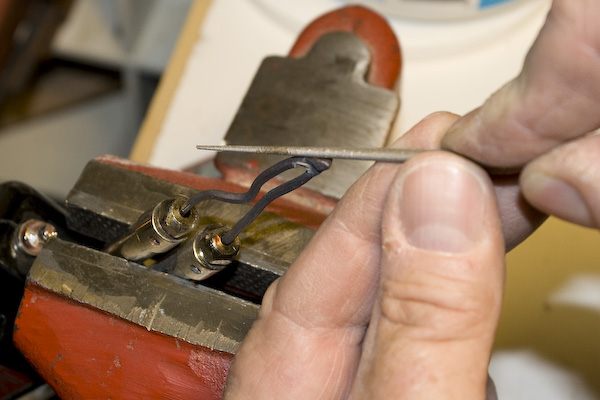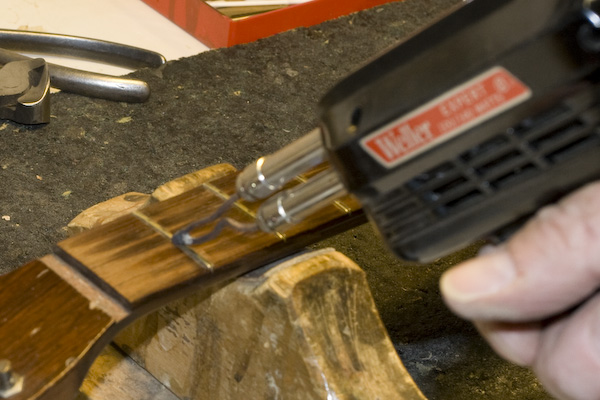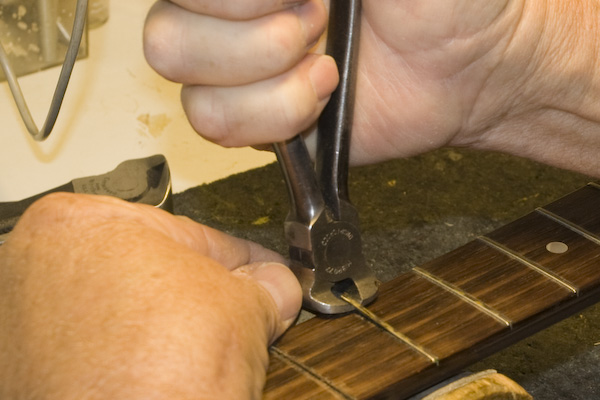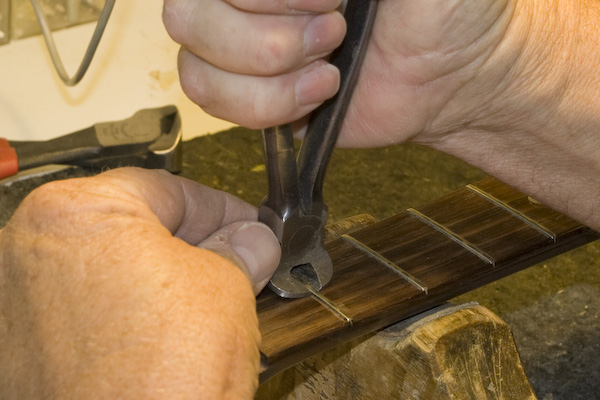Any hot tips for removing old frets?
Any hot tips for removing old frets?
Hi All
I have an old Simon and Patric dred that I want to make playable again. It has a number of minor problems like a cracked brace and a couple of cracks in the top near the edge of the upper bout. But the main issue with playability is that the strings have worn groves in the frets two to five almost to the level of the fret board.
It has done its time twice over and probably isn't worth doing a full rebuild on, but it had a nice sound so rather than have it sit gathering dust I thought it could be worth giving it a quick fix and putting it back into service as the guitar you take places you wouldn't take your good one.
My first thought was to pull off the fret board and replace the whole thing (still an option) but I was wondering if it would be possible to host refret it with the fretboard still on the guitar and if anyone had a hot tip on the best way of removing the old frets?
My thinking is that the problems of doing it as a half measure are going to cause me more grief that just doing it properly... any thoughts?
Cheers
James
I have an old Simon and Patric dred that I want to make playable again. It has a number of minor problems like a cracked brace and a couple of cracks in the top near the edge of the upper bout. But the main issue with playability is that the strings have worn groves in the frets two to five almost to the level of the fret board.
It has done its time twice over and probably isn't worth doing a full rebuild on, but it had a nice sound so rather than have it sit gathering dust I thought it could be worth giving it a quick fix and putting it back into service as the guitar you take places you wouldn't take your good one.
My first thought was to pull off the fret board and replace the whole thing (still an option) but I was wondering if it would be possible to host refret it with the fretboard still on the guitar and if anyone had a hot tip on the best way of removing the old frets?
My thinking is that the problems of doing it as a half measure are going to cause me more grief that just doing it properly... any thoughts?
Cheers
James
- sebastiaan56
- Blackwood
- Posts: 1274
- Joined: Sun Oct 28, 2007 5:23 am
- Location: Blue Mountains
Id try it, but I havent before so; http://frets.com/FRETSPages/Luthier/Tec ... ouble.html may help
Also,
http://frets.com/FRETSPages/Luthier/Tec ... ret01.html
http://frets.com/FRETSPages/Luthier/Tec ... fret1.html
Also,
http://frets.com/FRETSPages/Luthier/Tec ... ret01.html
http://frets.com/FRETSPages/Luthier/Tec ... fret1.html
make mine fifths........
Hi James
To add my bit to Kims comments ..
One tip I read somwhere was to find an old pair of pincers from a second hand shop and grind the top until you have a flat surface across the jaws and only a bevel on the inside. Go slowly and keep them cool to avoid drawing the temper out of the steel.
When you put them on the fretboard, the flat bits lay on the timber and there is then a knife edge at the base of the fret. A bit of gentle squeezing gets the edges under the fret and also because the jaws are pushing against the fretboard, that helps to minimise the chipping of the surface when the frets lift.
I have done the grand total one refret and enjoyed it, it was fun to do.
Good luck
To add my bit to Kims comments ..
One tip I read somwhere was to find an old pair of pincers from a second hand shop and grind the top until you have a flat surface across the jaws and only a bevel on the inside. Go slowly and keep them cool to avoid drawing the temper out of the steel.
When you put them on the fretboard, the flat bits lay on the timber and there is then a knife edge at the base of the fret. A bit of gentle squeezing gets the edges under the fret and also because the jaws are pushing against the fretboard, that helps to minimise the chipping of the surface when the frets lift.
I have done the grand total one refret and enjoyed it, it was fun to do.
Good luck
Richard
Refrets are not difficult and what the other guys said is good advice.
Heat each individual fret with the tip of a soldering iron and then with the nippers gently pull straight up, a little at a time, one side at a time. The frets will come right out and if your technique is decent you will have very little if any chip out.
The nice thing about a refret is that you have an opportunity to level the fretless neck with the truss rod and then really level the fret board with something like the Stew-Mac radius sanding beam.
Reinstall the frets, do a fret dress, make a new nut if needed, and your guitar will play fantastic.
I fret my guitars after the guitar is finished and with the neck on the board.
Good luck.
Heat each individual fret with the tip of a soldering iron and then with the nippers gently pull straight up, a little at a time, one side at a time. The frets will come right out and if your technique is decent you will have very little if any chip out.
The nice thing about a refret is that you have an opportunity to level the fretless neck with the truss rod and then really level the fret board with something like the Stew-Mac radius sanding beam.
Reinstall the frets, do a fret dress, make a new nut if needed, and your guitar will play fantastic.
I fret my guitars after the guitar is finished and with the neck on the board.
Good luck.
-
pat foster
- Myrtle
- Posts: 79
- Joined: Tue Apr 14, 2009 8:41 am
- Location: Eastern Washington, USA
- Contact:
I have to disagree with my friend Hesh about pulling straight up. I've had prefer doing what seeaxe recommends, pinching with the cutters. I get less splitting doing it this way. By pinching under the frets a little bit at a time, the cutting edges of the cutter act as a wedge between the fret and the board, so that as the fret is being wedged up, the board is being pushed down, and like Hesh said heat the frets before pulling. Work slow, taking little bites at a time, glue chips back in with CA as you go. When you're done, that thing will play better than when it was new.
Pat
P. S. So Hesh, haven't seen much of you lately on the forums. What have you been up to?
Pat
P. S. So Hesh, haven't seen much of you lately on the forums. What have you been up to?
Hi Pat!
I completely agree with you and should have gone into more detail in my post. Pull straight up, which requires no effort at all AFTER doing everything that you said. I also work both sides of the frets, heating both sides too and using the flush ground face of the nippers to as you said wedge the frets up.
Some folks do complain of chip-out but when you ask them they were not gradually wedging the frets straight up, one side at a time.
I am fine Pat - thanks for asking.
I completely agree with you and should have gone into more detail in my post. Pull straight up, which requires no effort at all AFTER doing everything that you said. I also work both sides of the frets, heating both sides too and using the flush ground face of the nippers to as you said wedge the frets up.
Some folks do complain of chip-out but when you ask them they were not gradually wedging the frets straight up, one side at a time.
I am fine Pat - thanks for asking.
-
Nick Payne
- Myrtle
- Posts: 87
- Joined: Tue Jun 10, 2008 9:31 am
- Location: Canberra
Stewmac sell ready-made fret pullers
http://www.stewmac.com/shop/Tools/Speci ... uller.html
And for the price it's probably cheaper than the time you'd spend in buying a set of end cutters and then grinding the bevel off the cutting edge. I purchased a pair of those in preference to spoiling my nice Bahco piano cutters that I've had for decades.

And for the price it's probably cheaper than the time you'd spend in buying a set of end cutters and then grinding the bevel off the cutting edge. I purchased a pair of those in preference to spoiling my nice Bahco piano cutters that I've had for decades.

Hi all,
This is my first post on this forum but I thought I'd give you a couple of tips that may make the job a bit easier.
First, everyone's advice is correct, as far as the technique of pulling old frets goes, but I've found that filing a slot in the soldering tip makes it a lot easier to hold the tip on the fret so you won't slip of and mark or burn the F.B.
I've attached a few photos.
This is a very good forum BTW.
Cal




This is my first post on this forum but I thought I'd give you a couple of tips that may make the job a bit easier.
First, everyone's advice is correct, as far as the technique of pulling old frets goes, but I've found that filing a slot in the soldering tip makes it a lot easier to hold the tip on the fret so you won't slip of and mark or burn the F.B.
I've attached a few photos.
This is a very good forum BTW.
Cal




- Mark McLean
- Blackwood
- Posts: 1174
- Joined: Thu Apr 10, 2008 2:03 pm
- Location: Sydney
Who is online
Users browsing this forum: Andos and 68 guests